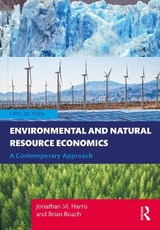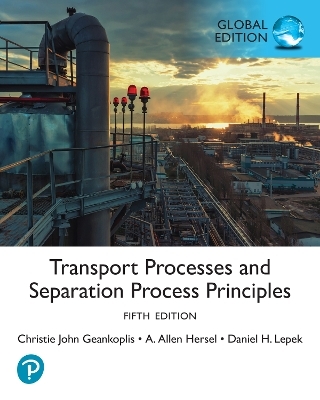
Environmental and Natural Resource Economics
Routledge (Verlag)
978-1-138-65947-6 (ISBN)
- Titel erscheint in neuer Auflage
- Artikel merken
Now in its fourth edition, this book includes new material on climate change, the cost-competitiveness of renewable energy, global environmental trends, and sustainable economies. The text provides a balanced treatment of both standard environmental economics and ecological economics, based on the belief that these two approaches are complementary. Several chapters focus on the core concepts of environmental economics, including the theory of externalities, the management of public goods, the allocation of resources across time, environmental valuation, and cost-benefit analysis. Material on ecological economics includes such topics as macroeconomic scale, entropy, and "green" national accounting. Topical chapters focus on: energy; climate change; water resources; international trade; forests; fisheries; and agriculture, with an emphasis on designing effective policies to promote sustainability and a "green" economy.
Harris and Roach’s premise is that a pluralistic approach is essential to understand the complex nexus between the economy and the environment. This perspective, combined with its emphasis on real-world policies, is particularly appealing to both instructors and students. This is the ideal text for classes on environmental, natural resource, and ecological economics.
The book's companion website is available at: http://www.bu.edu/eci/education-materials/textbooks/environmental-and-natural-resource-economics/
Jonathan M. Harris is Director of the Theory and Education Program at the Tufts University Global Development and Environment Institute, USA. His current research focuses on the implications of large-scale environmental problems, especially global climate change, for macroeconomic theory and policy. Brian Roach is Senior Research Associate at the Tufts University Global Development and Environment Institute and a lecturer at Tufts University and Brandeis University, USA. He has published numerous articles on non-market valuation of natural resources, including drinking water quality, water-based recreation, and wildlife.
PART ONE
INTRODUCTION: THE ECONOMY AND THE ENVIRONMENT
Chapter 1: Changing Perspectives on the Environment
1. Overview of Environmental Issues
2. Economic Approaches to the Environment
3. Principles of Ecological Economics
4. A Look Ahead
Chapter 2: Resources, Environment, and Economic Development
1. Overview of Economic Growth
2. Economic Growth in Recent Decades
3. Environmental Trends in Recent Decades
4. Optimists and Pessimists
5. Sustainable Development
PART TWO
ECONOMIC ANALYSIS OF ENVIRONMENTAL ISSUES
Chapter 3: The Theory of Environmental Externalities
1. The Theory of Externalities
2. Welfare Analysis of Externalities
3. Property Rights and the Environment
Appendix 3.1: Supply, Demand, and Welfare Analysis
Appendix 3.2: Externality Analysis: Advanced Material
Chapter 4: Common Property Resources and Public Goods
1. Common Property, Open Access, and Property Rights
2. The Environment as a Public Good
3. The Global Commons
Chapter 5: Resource Allocation Over Time
1. Allocation of Non-Renewable Resources
2. Hotelling’s Rule and Time Discounting
Chapter 6: Valuing the Environment
1. Total Economic Value
2. Overview of Valuation Techniques
3. Revealed Preference Methods
4. Stated Preference Methods
Chapter 7: Cost-Benefit Analysis
Overview of Cost-Benefit Analysis
Balancing the Present and Future: The Discount Rate
Valuing Human Life
Other Issues in Cost-Benefit Analysis
Cost-Benefit Analysis Example
Conclusion: The Role of Cost-Benefit Analysis in Environmental Policy Decisions
Appendix 7.1: Using Excel to Perform Present Value Calculations
Chapter 8: Pollution: Analysis and Policy
1. The Economics of Pollution Control
2. Policies for Pollution Control
3. The Scale of Pollution Impacts
4. Assessing Pollution Control Policies
5. Pollution Control Policies in Practice
PART THREE
ECOLOGICAL ECONOMICS AND ENVIRONMENTAL ACCOUNTING
Chapter 9: Ecological Economics: Basic Concepts
An Ecological Perspective
Natural Capital
Issues of Macroeconomic Scale
Long-Term Sustainability
Chapter 10: National Income and Environmental Accounting
1. Greening the National Income Accounts
2. Green GDP
3. Adjusted Net Saving
4. The Genuine Progress Indicator
5. The Human Development Index and the Better Life Index
6. Environmental Asset Accounts
7. The Future of Alternative Indicators
Appendix 10.1: Basic National Income Accounting
PART FOUR
ENERGY, CLIMATE CHANGE, AND GREENING THE ECONOMY
Chapter 11: Energy: The Great Transition
1. Energy and Economic Systems
2. Evaluation of Energy Sources
3. Energy Trends and Projections
4. Energy Supplies: Fossil Fuels
5. Renewable Energy Sources
6. The Economics of Alternative Energy Futures
7. Policies for the Great Energy Transition
Chapter 12: Global Climate Change: Science and Analysis
1. Causes and Consequences of Climate Change
2. Responses to Global Climate Change
3. Economic Analysis of Climate Change
Chapter 13: Global Climate Change: Policy Responses
1. Adaptation and Mitigation
2. Climate Change Mitigation: Economic Policy Options
3. Climate Change: The Technical Challenge
4. Climate Change Policy in Practice
5. Other Economic Proposals: Environment and Equity
6. Conclusion: Dimensions of Climate Change
Chapter 14: The Green Economy
1. The Green Economy: Introduction
2. The Relationship between the Economy and the Environment
3. Industrial Ecology
4. Does Protecting the Environment Harm the Economy? 5. Creating a Green Economy
PART FIVE
POPULATION, AGRICULTURE, AND RESOURCES
Chapter 15: Population and the Environment
1. The Dynamics of Population Growth
2. Predicting Future Population Growth
3. The Theory of Demographic Transition
4. Population Growth and Economic Growth
5. Ecological Perspectives on Population Growth
6. Population Policies for the Twenty-First Century
Chapter 16: Agriculture, Food and Environment
1. Feeding the World: Population and Food Supply
2. Trends in Global Food Production
3. Projections for the Future
4. Agriculture’s Impact on the Environment
5. Sustainable Agriculture for the Future
Chapter 17: Resources: Scarcity and Abundance
1. The Supply of Non-Renewable Resources
2. Economic Theory of Non-Renewable Resource Use
3. Global Scarcity or Increasing Abundance?
4. Environmental Impacts of Mining
5. The Potential for Minerals Recycling
Chapter 18: Renewable Resource Use – Fisheries
1. Principles of Renewable Resource Management
2. Ecological and Economic Analyses of Fisheries
3. The Economics of Fisheries in Practice
4. Policies for Sustainable Fisheries Management
Chapter 19: Ecosystem Management – Forest Ecosystems
1. The Economics of Forest Management
2. Forest Loss and Biodiversity
3. Policies for Sustainable Forest Management
Chapter 20: Water Systems
1. Global Supply and Demand for Water
2. Addressing Water Shortages
3. Water Pricing
4. Water Rights, Water Markets, and Privatization
5. Water as Common Property Resource
PART SIX
ENVIRONMENT, TRADE, AND DEVELOPMENT
Chapter 21: World Trade and the Environment
1. Environmental Impacts of Trade
2. Trade and Environment: Policy and Practice
3. Trade Agreements and the Environment
4. Strategies for Sustainable Trade
Chapter 22: Institutions for Sustainable Development
1. The Concept of Sustainable Development
2. The Economics of Sustainable Development
3. Reforming Global Institutions
4. New Goals and New Production Methods
5. Conclusion: Policies for Sustainable Development
| Erscheinungsdatum | 03.02.2018 |
|---|---|
| Zusatzinfo | Style copy Contemporary Economics 8e 978-1-138-65217-0 but in blue (Pantone 285c); 194 Line drawings, black and white; 46 Tables, black and white; 194 Illustrations, black and white |
| Verlagsort | London |
| Sprache | englisch |
| Maße | 189 x 246 mm |
| Gewicht | 1610 g |
| Themenwelt | Technik ► Umwelttechnik / Biotechnologie |
| Wirtschaft ► Volkswirtschaftslehre | |
| Weitere Fachgebiete ► Land- / Forstwirtschaft / Fischerei | |
| ISBN-10 | 1-138-65947-9 / 1138659479 |
| ISBN-13 | 978-1-138-65947-6 / 9781138659476 |
| Zustand | Neuware |
| Informationen gemäß Produktsicherheitsverordnung (GPSR) | |
| Haben Sie eine Frage zum Produkt? |
aus dem Bereich



